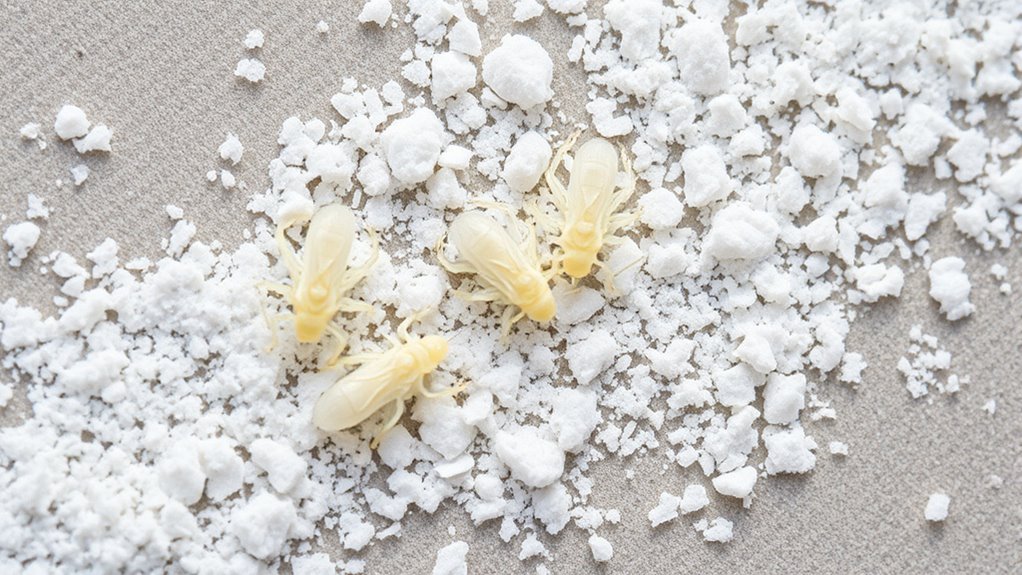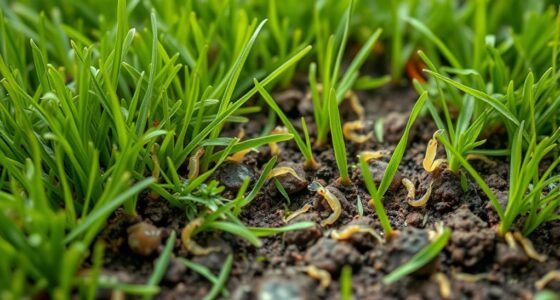To use diatomaceous earth against soft-bodied insects, focus on applying it directly to areas where pests hide, like cracks and leaf undersides. Wear protective gear and dust it evenly for best results, especially on dry days. It works by physically damaging the pests’ exoskeletons and dehydrating them. Reapply after rain or watering to maintain an effective barrier. Keep an eye on pest activity and learn more about proper application techniques as you continue.
Key Takeaways
- Diatomaceous Earth physically damages soft-bodied insects’ exoskeletons, causing dehydration and death.
- Apply DE directly to pest hotspots, cracks, and crevices where soft-bodied pests hide.
- Use a dusting tool for even coverage, focusing on affected plants and soil surfaces.
- Reapply after rain or watering to maintain a pest barrier, ensuring DE stays dry and effective.
- Wear protective gear during application to prevent irritation from the abrasive particles.
Understanding How Diatomaceous Earth Works on Soft-Bodied Pests
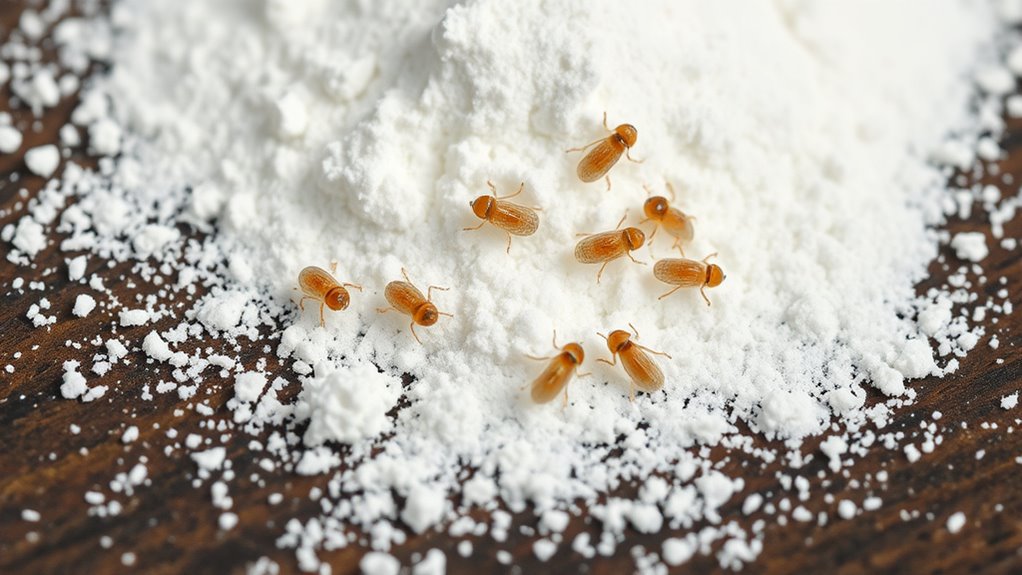
Diatomaceous earth works on soft-bodied pests by physically damaging their exoskeletons, leading to dehydration and eventual death. When insects crawl through the powder, their bodies absorb tiny, abrasive particles that cut into their outer layer. This process, known as insect absorption, strips away protective moisture, causing pest dehydration. Unlike chemical sprays, DE doesn’t rely on toxins; instead, it relies on its physical properties to control pests. As pests walk over the powder, they lose essential fluids rapidly, which results in their death within hours or days. This method is especially effective against soft-bodied insects like aphids, thrips, and mealybugs. By disrupting their moisture balance, DE provides a chemical-free, targeted approach to pest control.
Preparing Your Garden for DE Application
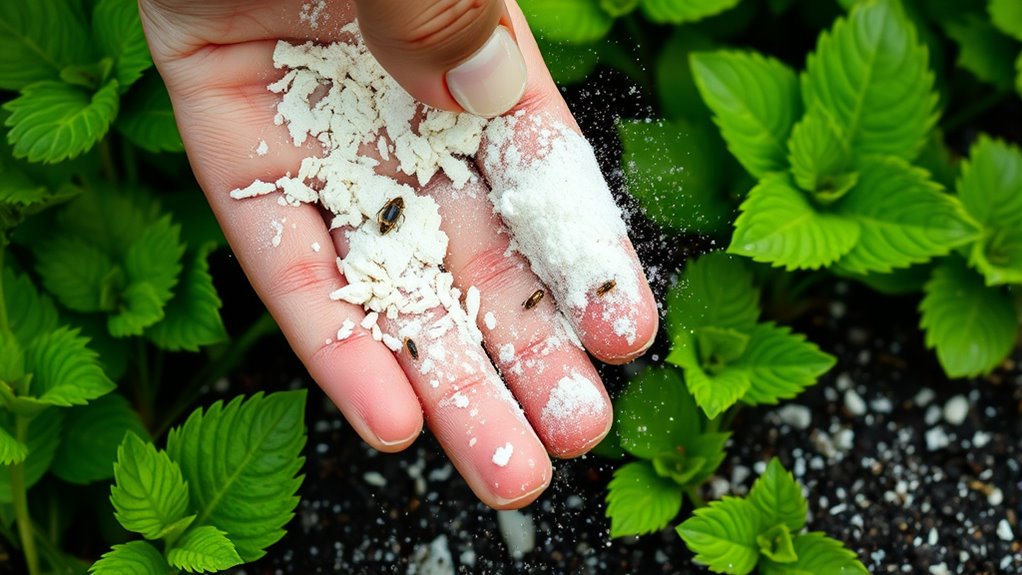
Before applying diatomaceous earth to your garden, you need to prepare the area to guarantee peak effectiveness and safety. Start by evaluating your garden’s soil health, ensuring it’s well-drained and free of debris that could interfere with DE application. Clear away fallen leaves, weeds, and organic matter that pests hide in. Proper pest identification is crucial—know which soft-bodied insects you’re targeting so you can focus your efforts effectively. If necessary, prune affected plants to improve airflow and reduce pest habitats. Water your garden lightly a day before applying DE, as moist conditions can diminish its effectiveness. By preparing your garden properly, you create an ideal environment for DE to work against pests while maintaining soil health.
Applying Diatomaceous Earth Effectively and Safely
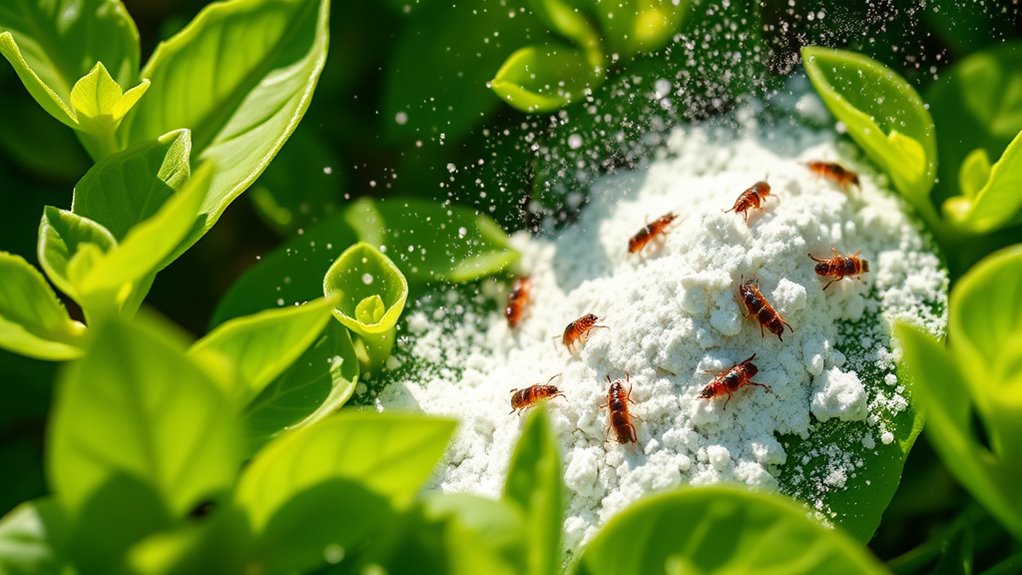
To apply diatomaceous earth effectively and safely, start by wearing protective gear such as a mask, goggles, and gloves to prevent inhalation or skin irritation. Proper pest identification ensures you’re targeting the right insects without harming beneficial ones. Spread the DE evenly over affected areas, focusing on cracks and crevices where pests hide. Be mindful of soil health; avoid excessive application that could disrupt beneficial organisms. Use a duster or sieve for precise distribution. Regularly monitor the treated zones for pest activity. Remember, DE works best when dry, so reapply after rain or watering. Keep in mind that careful application preserves soil vitality and ensures safety for your garden and environment. Additionally, understanding the filter types in air purifiers can help you select the best filtration method for your needs, ensuring optimal pest control and air quality.
Monitoring and Maintaining Pest Control With DE
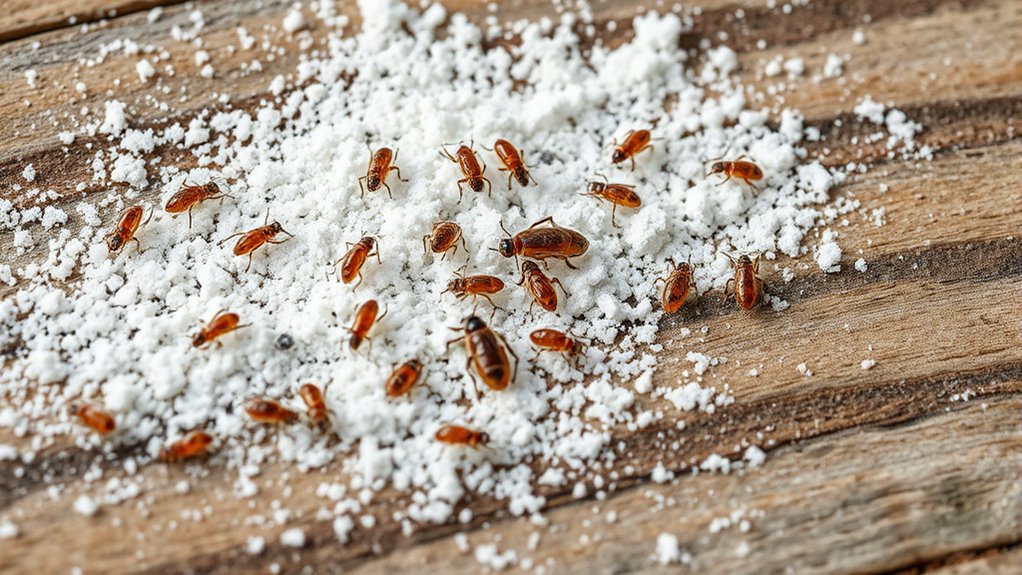
Regularly monitoring your garden is essential to guarantee that diatomaceous earth remains effective in controlling soft-bodied pests. By observing pest activity, you can identify infestations early and target treatment areas precisely. Keep an eye on soil health, as healthy soil promotes strong plants that are less vulnerable to pests. Accurate pest identification ensures you’re applying DE where it’s needed most, avoiding unnecessary coverage. Consistent monitoring also helps you spot any new pest issues before they escalate, allowing for timely intervention. Remember, maintaining soil health through proper watering and nutrient management supports your pest control efforts. Additionally, understanding the shelf life of grape juice can help you manage your resources better, ensuring your pest control supplies are stored properly. Regular checks and proper identification are key to sustaining an effective pest management routine using diatomaceous earth.
Additional Tips for Using Diatomaceous Earth in Your Garden
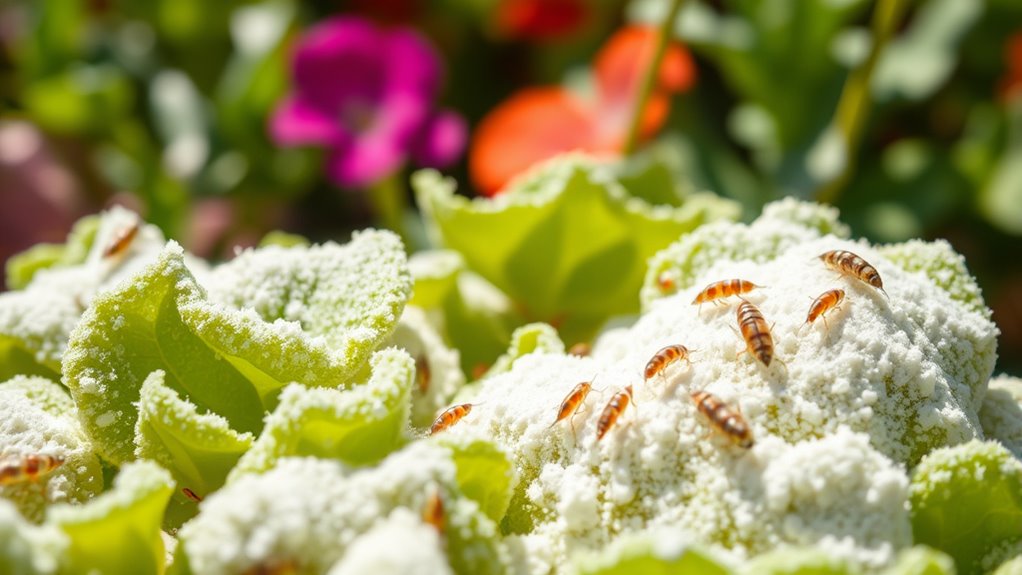
Applying diatomaceous earth correctly can considerably boost its effectiveness in your garden. To maximize results, consider these tips:
- Apply DE during dry weather, as moisture reduces its efficacy.
- Use natural repellents alongside DE to target pests more effectively.
- Avoid applying DE directly on beneficial insects; focus on pest hotspots instead.
- Reapply after rain or heavy dew to maintain a protective barrier.
- Spread DE lightly, ensuring even coverage without overdoing it.
- Be mindful of data privacy concerns when using automated pest control devices or connected garden systems regulatory frameworks.
Frequently Asked Questions
Is Diatomaceous Earth Safe for Pets and Children?
You wonder if diatomaceous earth is safe for pets and children. Generally, food-grade diatomaceous earth is considered safe when used properly, providing good pet safety and child protection. However, it’s crucial to avoid inhaling the dust and keep it away from their eyes and mouths. Always follow label instructions, apply in areas out of reach, and consult a veterinarian or pediatrician if you’re unsure. Proper use guarantees safety for your loved ones.
How Long Does DE Remain Effective After Application?
You might think D.E. is a magic fix, but its effectiveness isn’t eternal. Once you apply it, de longevity varies with conditions—usually lasting about a week before it needs reapplication. Proper application timing is key; reapply after rain or heavy dew to keep pests at bay. Ironically, D.E. works best when you stay vigilant and reapply regularly, turning a simple powder into a persistent pest barrier.
Can DE Be Used Indoors for Pest Control?
You can definitely use diatomaceous earth for indoor application to help with pest eradication. It’s safe to spread in cracks, crevices, and on surfaces where pests hide. Just guarantee good ventilation and avoid inhaling the dust. This natural method works effectively against soft-bodied insects indoors, providing a non-toxic solution for pest control. Remember to reapply as needed, especially after cleaning or vacuuming, to maintain its effectiveness.
What Environmental Conditions Reduce De’S Effectiveness?
Imagine a delicate, shimmering dust settling softly onto surfaces. Your diatomaceous earth’s effectiveness diminishes in high humidity interference, where moisture clings to its tiny particles, reducing their sharpness. Rain washout can quickly sweep it away outdoors, leaving pests unbothered. To keep it working, guarantee dry conditions and avoid excessive humidity. Proper application in dry, sheltered areas helps your natural pest control stay active and effective.
Are There Any Plants That Should Not Be Treated With DE?
You should avoid treating plants that are sensitive to diatomaceous earth because of potential plant toxicity. Some delicate plants may suffer damage or stress from the abrasive nature of DE. Additionally, applying DE can harm non-target insects, including beneficial ones. To protect your garden, check plant labels and research specific plant tolerances before using DE, ensuring you don’t unintentionally damage your plants or beneficial insect populations.
Conclusion
Just like the old stories of Hercules overcoming monsters, you can conquer soft-bodied pests with diatomaceous earth. When you understand how it works, prepare wisely, and apply carefully, you become the hero of your garden. Keep an eye on your plants and maintain your pest control efforts, and you’ll enjoy a thriving, pest-free oasis. With patience and persistence, you’ll turn your garden into a sanctuary, proving that even the tiniest warrior can achieve great victory.
